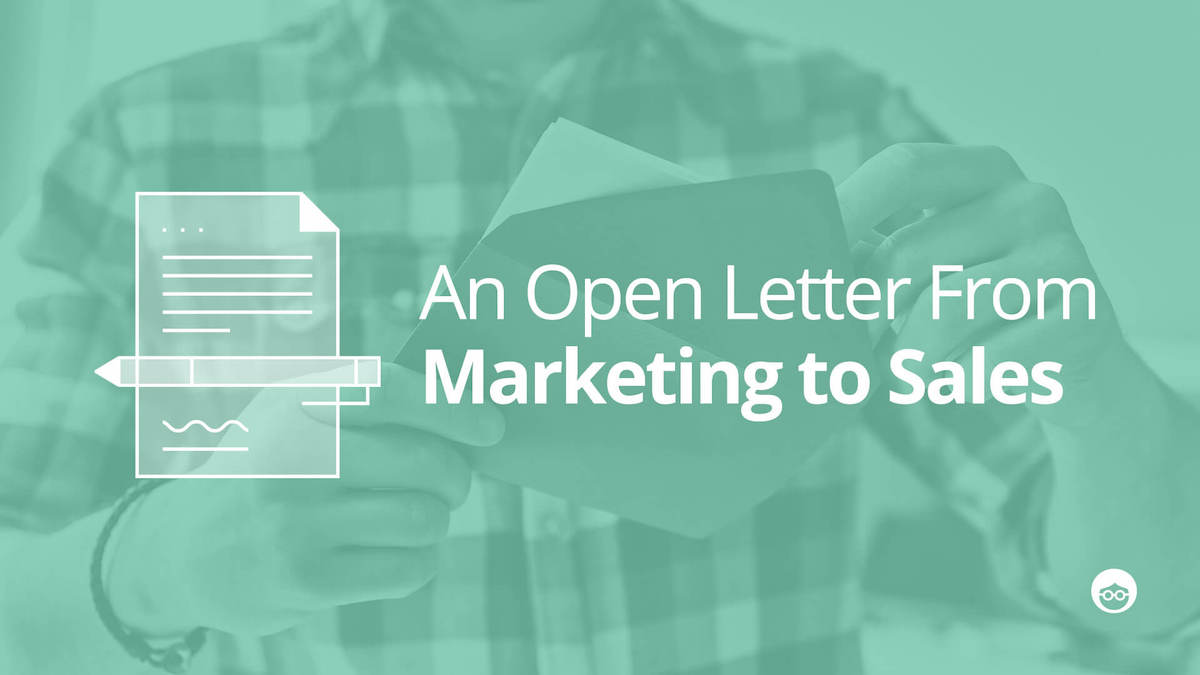Inbound Leads: An Open Letter From Marketing to Sales

Sales and marketing. Two different and separate teams working together towards a common goal.
Like any relationship, there are frustrations and disagreements – especially when one team relies on the other to achieve an important task (can you say “inbound lead follow-up”?)
Yet with good communication and goodwill, sales and marketing teams can support each other more efficiently to turn those inbound leads into customers. The following letter by marketing exec Jarrod Wright contains everything that marketing has wanted to say to their sales team for a long time. You’ll wish you wrote it!
Here’s to better, smoother lead follow-up – and a little touch of humor to help us all succeed.
Dearest Sales,
We think it’s time to have a conversation about inbound lead follow-up.
Here in Marketing, we work very hard to generate a steady stream of B2B inbound leads. We write content, run campaigns, and produce creatives in an elaborate process most people never see.
Our inbound funnel is an engine that was painstakingly built through years of tedious (often imperceptible) gains. Each demo request, eBook download and chat request is a product of our hard work.
These leads are important to us…which is why we get so frustrated when your follow-up doesn’t meet our expectations.
This letter outlines what we over in Marketing hope to see in a B2B inbound follow-up strategy. But first, we want to clarify a few points:
- We know we can’t do this without you.
Unlike many of our B2C counterparts, we can’t impact revenue directly. You play an invaluable role in this process, and we’re grateful for everything that you do. We don’t say it enough but thank you. - We just don’t understand.
Your Sales swagger seems like magic to us Marketing nerds. We’re impressed by your persuasive charm and respect your ability to remain cool under pressure. You think we don’t understand everything you do … and frankly, you’re right. Sales is hard; take it from us, marketers just don’t understand. - We have obligations, too.
In this letter, we focus on what we want from Sales, but we understand that we play a role in this, too. We know, for example, that Marketing needs to be better at qualifying and segmenting opportunities, so you aren’t wasting time chasing poor-fit, low-quality leads. We’re happy to hear from you on ways we can help.
Understanding the Problem
Every B2B Marketing team is unique. We define prospects differently, employ different strategies, and deal with our own set of challenges. The inbound leads we generate, however, can usually be segmented into three buckets.
- Hand Raisers
- Information Seekers
- Problem Solvers
Each lead type requires a different strategy and process. The quality of each lead can vary, of course, but in this letter, we are only talking about the qualified, good-fit leads. Those are the leads that we’re most likely to hand to Sales; they’re also the leads that are keeping us up at night.
We know we don’t have all the answers; this is just our attempt to shed light on our thinking. It’s our hope that by outlining our expectations (rather than prescribing a specific solution), we can together bridge the divide that currently exists on this very important area of mutual investment.
Following Up With Hand Raisers
Qualified Hand Raisers are the holy grail for both departments. These leads have been identified as a good fit for our solution and have indicated that they want to learn more. It’s imperative that we prioritize these opportunities above nearly everything else. They are rare, expensive to acquire, and the most likely to result in revenue.
If inbound marketing delivered only qualified, hand-raising leads, it would be easy to envision a world where Marketing and Sales commonly existed in perfect alignment. But even with these unicorns, follow-up matters; in fact, since the stakes are higher, follow-up matters even more.
Here are the elements of a successful strategy that every marketer wants to see:
-
- Follow Up Fast
Call these leads as quickly as possible. Studies show that a prospect will typically choose the first company to respond: we want to be that company. We want you to call within 5 minutes of receiving the lead. If that doesn’t seem feasible, let’s have a conversation about how we can help make it feasible. - Follow Up Often
Unlike other types of inbound leads, a hand-raiser wants and expects to hear from you. People are busy, that doesn’t mean that they aren’t interested. Should you fail to connect on your first attempt, you should follow up again and again, trying various channels including phone, email and LinkedIn. You should reach out every day for at least a week before transitioning to a slower cadence. - Think Outside the Box
- Follow Up Fast
We’re glad you like the template we wrote, but these hot leads deserve better. If they don’t answer your call, research them before sending them an email. Personalize your emails so they know that you care about earning their business. Did the phone number they gave you not work? It might be a typo. Try doing some research before setting the lead aside.
Success, for this type of lead, should be measured in the number of meaningful meetings set.
Following Up With Information Seekers
Qualified Information Seekers are a good fit and have provided us their information. However, these leads aren’t specifically interested in learning more about our solution. If qualified hand raisers are lead unicorns, qualified information seekers are lead mules.
By comparison, these webinar attendees and eBook downloaders are common and easy to acquire. While one or two may be immediately interested in our solution, the vast majority won’t.
Most of the value in these leads can be realized through a long-term relationship building, rather than a straight-ahead selling. As a result, there is some debate as to whether these opportunities should be handed to Sales at all.
For those of us that have decided to bring Sales in to handle the follow-up, here is what we marketers would like to see:
- Be helpful
These leads did not ask to hear from you, so avoid pitching our solution in any initial correspondence. Instead, ask their opinions and try to learn about their business. Your primary goal should be to establish a relationship rather than close a deal. Don’t sour a potentially fruitful long-term opportunity by worrying too much about short-term gains. If the prospect is open to hearing a pitch, they will let you know. Don’t worry if they don’t respond. You’ll get them next time.
- Be persistent but patient
We still want you to follow up several times, through various channels, but over a longer period than with Hand Raisers. Different situations will require different cadences, but generally we want to see at least 5 personalized touches spread out over a few weeks. Other, long-term drip campaigns can be effective if they are well targeted and well planned.
- Have a plan
Getting a prospect to respond to an email or answer your phone call is your first challenge, but when they do, it’s essential that you have a plan for turning that response into a conversation. Those conversations will be your best tools for developing both long-term and short-term opportunities. For example, if you ask their opinion on a piece of content, you’ll need to have a plan for if they reply either “it was good” or “it was bad.” Don’t let any response other than “never contact me again” mark the end of your engagement efforts.
Success, for this type of lead, should be measured in the number discovery conversations had.
Following Up With Problem Solvers
Qualified Problem Solvers are a good fit and have provided us their information. They aren’t specifically interested in learning more about us, but there is some indication that they actively evaluating solutions.
These mule-icorns (or uni-mules) exist somewhere along the spectrum between Hand Raisers and Information Seekers. These awkward hybrids aren’t ready for the full court press, but they do deserve additional attention: they didn’t raise their hands, but they did wink at us from across the room.
Qualified Problem Solvers may have downloaded a very relevant piece of content like an eBook entitled “How to Select the Best _____ Company” or they may have checked a box requesting to learn more when registering for a webinar.
There are no set rules for this type of lead. Rather, we encourage Sales to select appropriate strategies on a case-by-case basis. As long as the strategy is personalized, nuanced, and falls somewhere in the “Goldilocks Zone” between the aforementioned poles, we’ll consider it just right.
A Way Forward
Marketing wants nothing more than for Sales to succeed.
And while we both pay lip service to the virtue of a singular, fully integrated revenue team, the truth is that, in most companies, the forces separating Marketing and Sales are greater than our desire to combine them. Like oil and vinegar, without constant effort, our two departments will naturally divide along a single shared membrane. But it is along this shared border that inbound leads reside.
Without establishing consensus around inbound follow-up, resentment and distrust will define our relationship, making additional cooperation all but impossible. So Sales, now that we’ve outlined our expectations, can you take things from here? We know you don’t like it when we tell you what to do, but we’re happy to help in any way you need us.
And once we tackle this topic, we’d love to hear your feedback on that flyer we just designed. You said something about it being not “designy” enough…tell us more.
Sincerely,
Marketing
PS: We’re sorry for joking that you don’t do anything at trade shows but party. We know that isn’t (completely) true.













